On the vast waters of the Mediterranean Sea lies Crete – the largest of the Greek islands. It has effortlessly won the hearts of travelers from around the world, who, in addition to its paradise-like beaches, discover the extraordinary remnants of its rich history. Here’s one of them.
The Palace of Knossos is an architectural masterpiece left behind on the island of Crete by the Minoan civilization. Not only is it the largest, but also the longest-inhabited Minoan palace on Crete. It is located about 6 km southeast of the city of Heraklion, amidst olive groves, vineyards, and cypress forests. In ancient times, it was said to have been the residence of the famous King Minos and the Minotaur, known from Greek mythology. Today, no one lives there anymore, but that doesn’t mean its “interiors” fail to impress the crowds of visitors.
History of the Palace of Knossos
The first Palace of Knossos was built around 1900 BCE, but it is not its ruins that we can see today during a visit. It suffered extensive damage during an earthquake in 1700 BCE, but construction of a new, larger, and more impressive residence began immediately, which still maintained an architectural layout similar to the original palace. This is the structure that is regarded as the cornerstone of the entire Minoan civilization.
In 1450 BCE, nearly all Minoan palaces on Crete were destroyed and abandoned. This was due to a combination of the Achaean invasion, the volcanic eruption on nearby Santorini, and several earthquakes. However, one construction survived—Knossos not only endured but also flourished, as evidenced by numerous archaeological finds. Yet, just 100 years later, the palace fell into complete ruin, and while some of its rooms were rebuilt, Knossos ceased to be the island’s center for good. The grandeur of its history, however, survived not only in memory but also in the myths of ancient Greece.
The Rediscovery of the Palace Ruins
How did the palace complex come to light again? The first fragment of the ruins, namely the eastern entrance, was discovered during excavations in 1878 by Minos Kalokerinos, an antiquarian from Heraklion. However, he didn’t have enough luck to go down in history as the discoverer of the entire palace. That honor belonged to an Englishman. In 1900, Sir Arthur Evans, director of one of Oxford’s museums, bought the entire hill and began long-term excavations there. It was during this time that the extensive palace ruins, covering nearly 17,400 m², were uncovered thanks to the work of a group of archaeologists.
GOOD TO KNOW: Evans also proposed reconstructing the entire complex, though not all experts today believe this was a good idea. Many historians criticized the Englishman, claiming that his vision had little to do with the original structure, as he based it neither on scholarly knowledge nor any primary documents. Nonetheless, the colorful frescoes and distinctive room names are among the palace’s features that draw the largest crowds to Knossos today.
The House of the Great Minotaur
Time for a brief reminder from history class. According to Greek mythology, King Minos asked Daedalus, the Athenian inventor and architect, to build a complex labyrinth with no way out. He wanted to imprison within it the dangerous beast Minotaur, a creature with the body of a man and the head of a bull, which terrorized the people of Crete. The king intended to offer seven girls and seven boys to the monster as a sacrifice. One of them was Theseus. You probably remember what happened next—Theseus killed the Minotaur, and he was saved by Ariadne, the daughter of King Minos, who helped him exit the labyrinth by unspooling the famous thread.
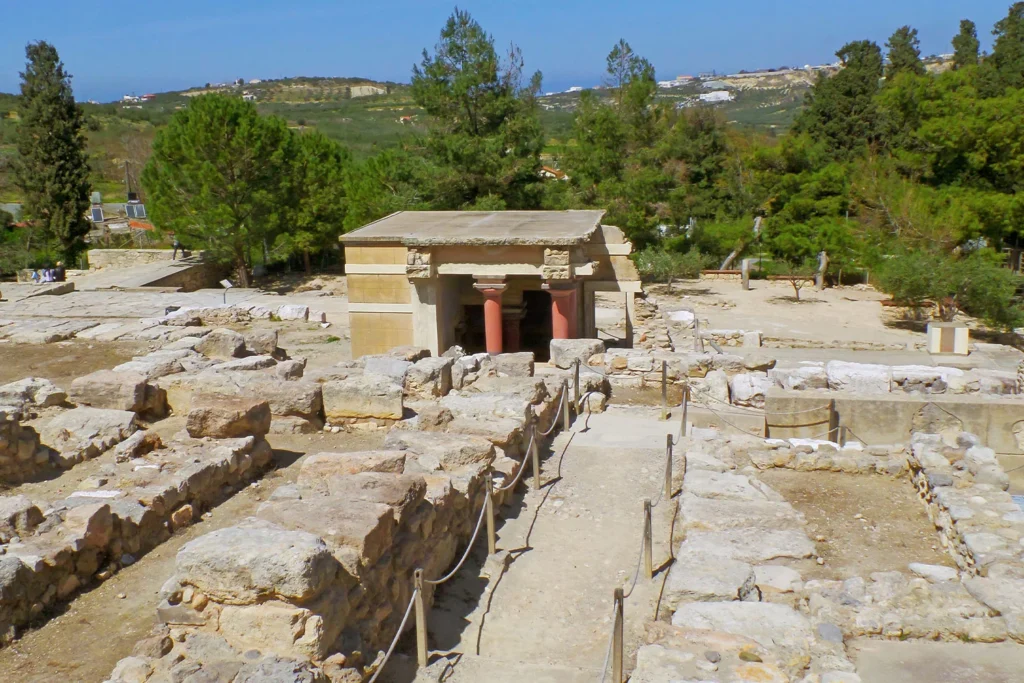
It is believed that the famous structure where the Minotaur was held was built near the Palace of Knossos. So, where is the supposed labyrinth now? Some claim to find its remains near the palace. However, another theory suggests that the palace itself, with its intricate, narrow corridors full of secret passages and nooks, made the Minotaur feel like he was trapped in an inescapable maze.
What Did the Palace of Minos Look Like?
The Palace of King Minos was built on the hill of Kephala, giving it easy access to both the sea and the island’s interior. It was a multi-story building covering nearly 20,000 m². The entire structure of the palace surrounded a large central courtyard, which was often used for public gatherings. Within the palace grounds were administrative, religious, and economic chambers, as well as living quarters and large reception halls.
While most popular rooms are located on the eastern and western sides of the palace, it is likely that the southern and northern sides will leave the greatest impression on you. This is where the most famous frescoes of the palace, the “Bull-Leaping” fresco and the “Prince of the Lilies” fresco, are found. Trust me, these artworks amaze every visitor to Minos’s former residence.
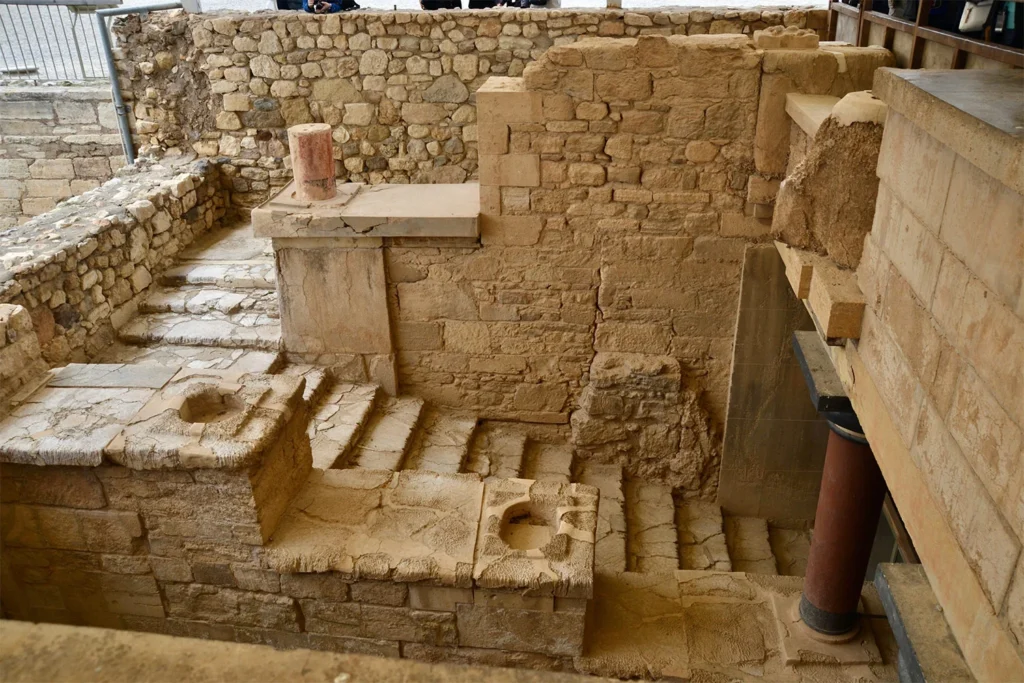
What fascinated the archaeologists uncovering this palace was something else. The building was constructed using an impressively diverse range of materials, and the advanced technological level achieved by the Minoans is evident in the complex drainage and water systems, light wells, and innovative methods of wall reinforcement.
The Eastern Wing
This part of the palace had four floors. Of course, to see this today, you’ll need to use your imagination. With a bit of creativity, you can also picture the storage rooms and luxurious Minoan chambers. Among these, the Hall of the Double Axes, with the sacred symbol carved into the wall of the inner corridor, and the most famous of all, the Queen’s Megaron, stand out.
It is in this royal space that you can see a colorful fresco depicting dolphins. However, the idea for this specific decoration didn’t come from a Minoan architect or interior designer but rather from Sir Arthur Evans, who likely copied the idea from other remnants of decorations found in the area. In the adjacent room, a clay bathtub has also been preserved, leading to the interpretation of the room as the queen’s bathroom, while the inner room with a stone seat connected to a system resembling a sewer was considered to be a toilet.
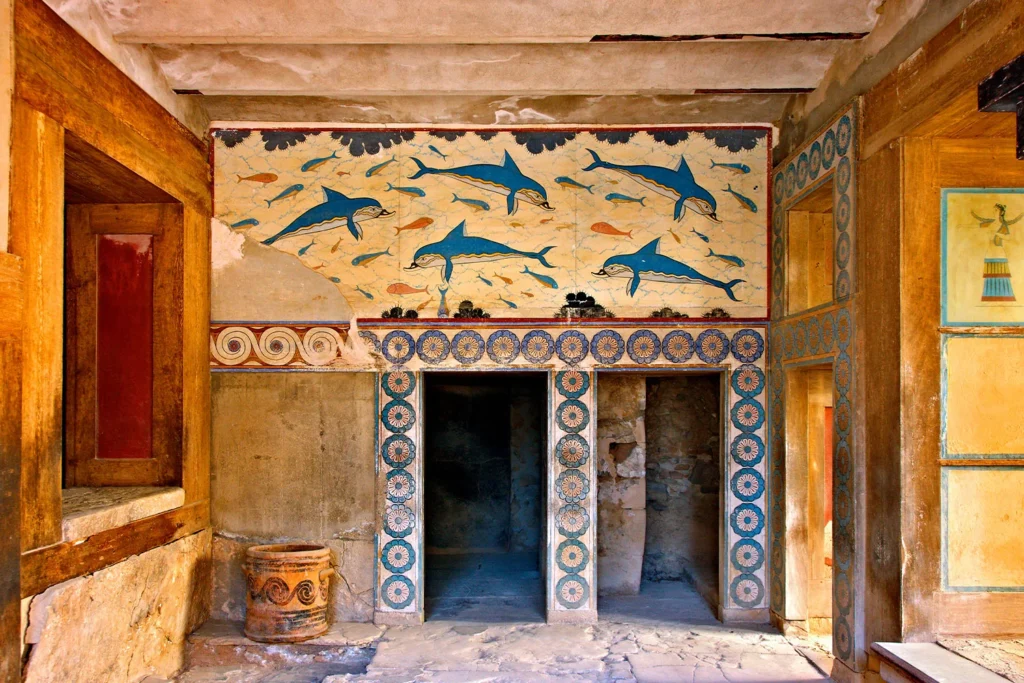
How do we know that the rooms discovered in this part of the palace were the private chambers of the royal couple? Well… we don’t. When Evans conducted the excavations, he envisioned the private aspects of the life of Minos and his wife in these spaces, and his opinion echoed through to modern times. Today, more and more historians believe these were simply religious spaces, reception halls, or residential quarters for the servants—and they have evidence to support this. The rooms are located below the level of the central courtyard, which is not a prime position within the palace. Besides, what king would want his private chamber next to workshops and storerooms?
The Grand Staircase
The Grand Staircase, connecting all floors of the eastern wing, is considered one of the most impressive construction achievements of the Minoans. Two stairways on each floor and the low steps made it easy for anyone in the palace to ascend. Equally significant attention was paid to decorating the staircase. It’s difficult to decide whether the elegance came more from the balustrades made of painted columns or the colorful frescoes that likely adorned the side walls.
The Western Wing
Experts believe that this side of the palace had only two floors. A few steps led down to the ground-floor rooms, slightly below the level of the courtyard. Here, in the western storerooms, there were 18 long, narrow chambers where both food supplies (those stored for later consumption and for trade) and other valuable palace items were kept. Impressive steps led upward to the Noble Floor rooms. The objects found on this floor suggest that important treasuries and opulent reception halls, adorned with columns and frescoes, were located there. It’s likely that religious ceremonies and rituals were held here, and valuable vessels and cult items were stored.
The Throne Room
This room was particularly elaborate. Both the floor and walls were lined with multicolored stone slabs and decorated with frescoes. However, this wasn’t the only indication that this was a throne room. Rows of low stone benches were interrupted by two seats—one stone throne and one wooden throne. Interestingly, the stone throne discovered during excavations not only influenced the interpretation of this room but also shaped the understanding of the entire building.
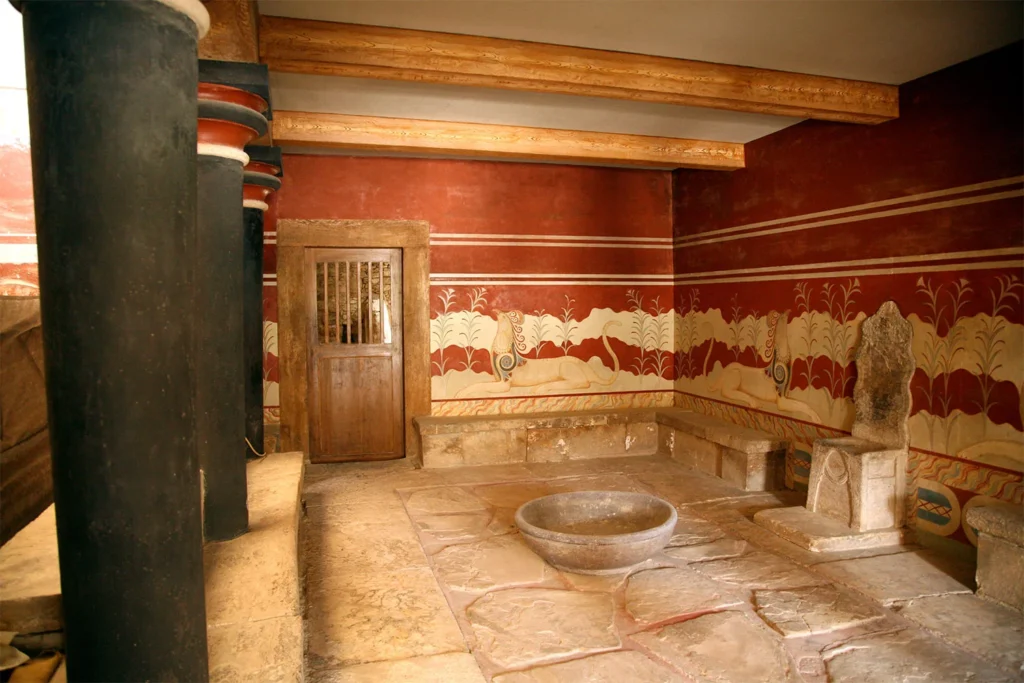
According to Evans, the throne belonged to King Minos himself. However, later studies began to debunk this theory. Opposite the alabaster seat, there was an underground room called the “Lustral Basin.” Some scholars associate it with sacramental rituals, during which the goddess, usually represented by the high priestess, would emerge from the dark chambers and take her place on the official seat in the main chamber.
Southern Facade of the Palace of Knossos
The southern facade of the palace is one of the most severely damaged parts of this architectural wonder. The rectangular platform beneath your feet is the only sparse remnant of the southern entrance. However, this isn’t what will hold your attention. In this area, Evans placed a replica of the famous “Prince of the Lilies” fresco, one of the most iconic Minoan images. It depicts a young priest wearing a crown of lilies and peacock feathers, leading a griffin by a leash.
Not all researchers agree with the reconstruction of this highly fragmentary fresco, especially regarding the identification of the main figure. Some argue that it depicts a woman, while others claim it shows a young man, whose muscular physique suggests an athlete rather than a young king.
Northern Entrance to the Palace
It is believed that the northern entrance to the palace was primarily used by people arriving from the port of Knossos, located in today’s Poros district of Heraklion. Following this theory, Evans identified a small room in front of the entrance as the “customs chamber,” where palace officials would inspect goods arriving from the port.
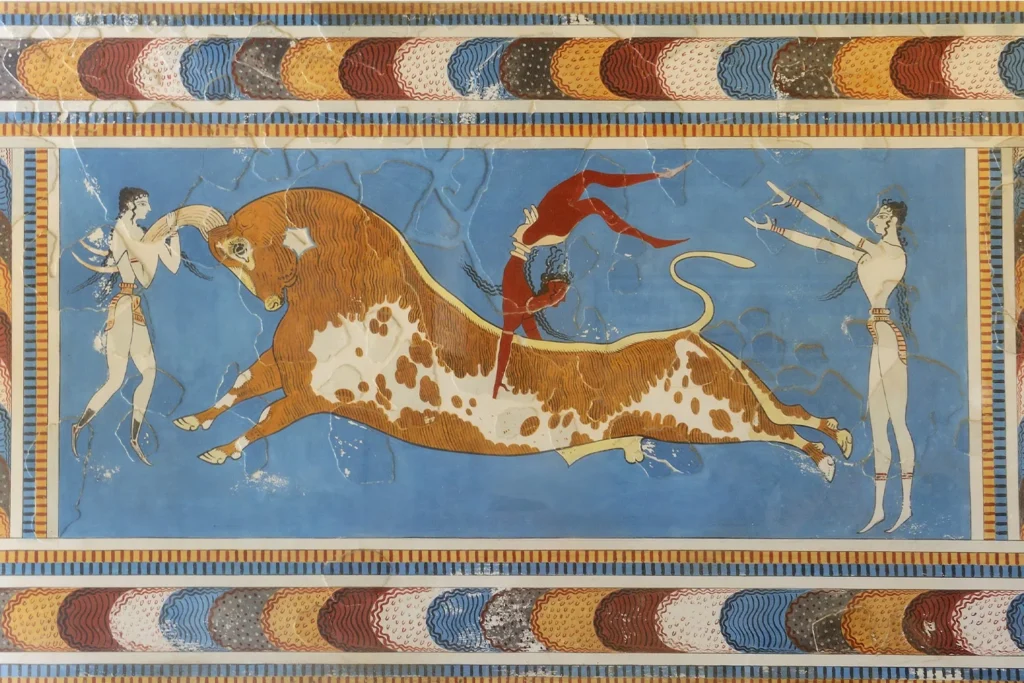
This is where the true hallmark of the palace is located—during archaeological work, remnants of a relief fresco were discovered on the facade of one of the bastions, covered by a kind of veranda. Based on the preserved fragments, Evans concluded that the fresco depicted the capture of a wild bull in an olive grove, and a copy of this image was placed on the wall of the bastion. Today, the scene of the charging bull is probably the most well-known and iconic image of the Palace of Knossos, continuing the special role of the bull in the iconography of the Minoan palace.
FUN FACT: From the northern part of the palace, a carefully paved road extended, which Evans himself dubbed the Royal Road. It was primarily the main route leading to the city but also a section that directly connected the main Palace of Knossos with the Small Palace.
Small Palace
Close to the Palace of Knossos lies the so-called Small Palace, an administrative center for the entire settlement, located on the western side of the central courtyard of the Palace of Knossos. What was its function? It served as a residence for the royal family and, at the same time, as an administrative hub for the area surrounding the palace. Over the centuries, the small building suffered from various causes, but thankfully, a significant effort has been made in its renovation and conservation to preserve its grandeur and present it to future generations.
The Small Palace essentially consisted of several interconnected buildings, including the western wing, living quarters, storage areas, and a central courtyard surrounded by square columns, which served as the heart of the palace. Inside, you can still see remnants of an elaborate system of corridors and staircases, as well as decorative elements, primarily in the form of frescoes.
Many might be interested to know that the residence not only served as an administrative and residential hub but also as a religious and ceremonial center. Sacrifices were made there, and purification rituals were conducted, as evidenced by the ritual vessels found, such as libation cups and special clay figurines.
Archaeological Museum of Heraklion
A great idea to complement the knowledge gained at the Palace of Knossos and to better recreate a complete image of the palace in your imagination is to visit the Archaeological Museum of Heraklion. One of the most important museums on the island houses an impressive collection of artifacts from over 5000 years of history.
The institution will transport you to the fascinating Minoan era, the oldest known civilization in Europe. You’ll see stunning frescoes from the Palace of Knossos (including the original “Prince of the Lilies” and “Bull-Leaping” frescoes), pottery, figurines, stone vases, and other valuable treasures uncovered at the site. You’ll be particularly captivated by the Snake Goddess statue, discovered in the Small Palace. This figurine, highlighting the role of women in Minoan religion and society, fascinates visitors with its intricate details and profound symbolism.
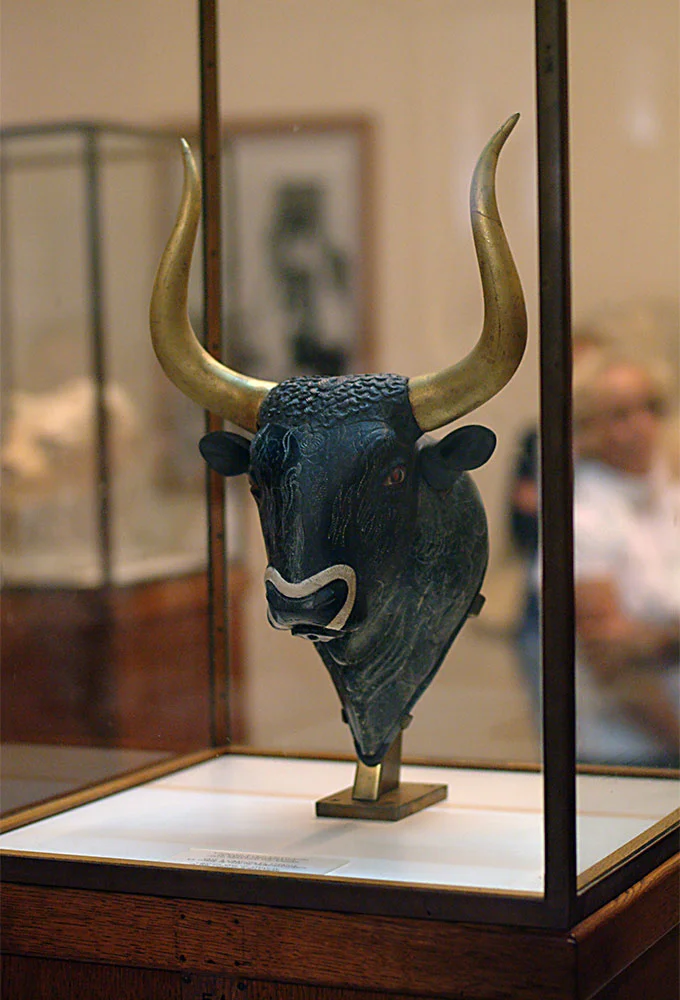
Interestingly, the museum not only showcases finds from the Palace of Knossos but also other artifacts from the Minoan civilization. A special highlight is the Minoan pottery, as well as the jewelry and other items made from ivory.
How to Prepare for the Trip?
The most convenient way to reach the Palace of Knossos is by renting a car. You can book one, for example, via the RentalCars website. This option gives you the freedom to explore at your own pace and, most importantly, discover other magical spots on the island. However, not everyone needs to be mobile, and that’s perfectly fine. If you’re in this group, you can take advantage of public transport. Buses depart every couple of hours from the station in Heraklion and drop passengers off almost directly at the archaeological site.
It’s a good idea to plan your visit to the Palace of Minos before arriving. Why? Purchasing tickets online allows you to skip any possible lines at the ticket office, but tickets are sold not only for a specific day but also for a specific time. Additionally, you won’t be able to change this time, and you’ll be allowed to enter the site no more than 15 minutes before or after your designated time.
If you’re already certain that the Minoan civilization will completely fascinate you, opt for a combined ticket to both the Palace of Knossos and the Archaeological Museum of Heraklion to save some money. An interesting option for those heading to Minos’ residence not just for photos is a guided tour. During such a walk, experts reveal all the secrets of the Minoans, talk about the history and customs, helping visitors recreate the vision of the palace during its golden years. Whether you prefer an audio guide, exploring the site independently, or the company of an expert, all tickets can be found on this site.
GOOD TO KNOW: The archaeological site is quite extensive, and the ruins don’t offer much shade, so especially in peak season when the Greek sun is relentless, it’s best to wear light, breathable clothing, apply sunscreen, and wear a hat. These essentials will certainly make your visit more enjoyable in the summer heat. Also, don’t forget to wear comfortable and stable shoes, as the terrain of the excavation site is not the most even.
Practical information
- It is best to purchase tickets for the Palace of Knossos in advance. This way, you can avoid standing in long lines and reduce the risk of tickets being sold out.
- Address: Knossos 714 09, Greece
- Buy tickets on GetYourGuide